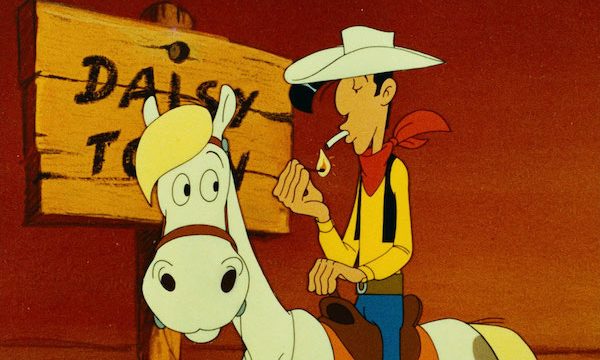When I was young, I read every Asterix the Gaul book I could get my hands on. I loved the silly puns, the adventures, the (alternate) history, and the art style. It was my first introduction to French comics (the Smurfs, of course, were my first introduction to French cartoons). Created by the French author-illustrator team of René Goscinny and Albert Uderzo, the franchise even sports a theme park more popular with locals than Euro Disney. (For some years, it was more popular than Euro Disney, full stop.)
Lucky Luke, created by Goscinny and Belgian artist Morris, is an also-ran to Asterix’s enormous success, not as well-known around the world or as popular in France (though it was still an international phenomenon translated into dozens of languages). Luke, in contrast to the patriotically themed Asterix, is a cowboy in the American West, smoking tiny roll-up cigarettes and looking, well, extremely French for an American cowboy, truth be known.
Many non-American readers will recognize the art style, even if they haven’t encountered those specific cartoons. French comics and cartoons of the postwar era often used a balloony, loose style that emphasized expression and movement.
A handful of animated specials featuring Luke and Asterix even made it across the Atlantic; Disney put out Lucky Luke and the Ballad of the Daltons on VHS, and several Asterix specials (Cleopatra was probably the best of the ones I’ve watched) made it officially to the US as well. There were live-action Lucky Luke and Asterix movies as well, including a few Asterix films with Gérard Depardieu as the hero’s costar and best friend Obelix. They’ve always been more cult movies than popular hits here.
Daisy Town (sometimes re-titled as Lucky Luke) was probably one of the best efforts to have that crossover success. It’s probably just as well it didn’t pull it off.
Half-spoof, half-homage to classic Wild West movies, it unfortunately echoes the worst of those movies when resorting to racial stereotypes, which gets particularly offensive in the third act when the Daltons enlist some Plains tribes as part of their plot to destroy the town. (Why yes, they do have a totem pole, why do you ask?) Some of the humor is of the “equal opportunity offender” ilk, and there are, to its credit, a few sly jokes, such as the tribal chief speaking English perfectly fine despite expectations, but overall, the jokes are lazy and uncomfortable. (There is one particularly pointed bit of dark humor in that third act, though: the “bad guy” Daltons convince the Indians to help them by explaining that the white men will bring railroads and utterly destroy their way of life. Ouch.)
That’s probably not what stopped the movie from greater crossover success, though, at least not for the first few decades after its release. I think the thing might be just a bit too, well, French.
Luke is a low-key hero, partial to one-word answers, continually smoking tiny roll-up cigarettes that his clever horse Jolly Jumper helps seal with a lick. He’s cooler than a Steve McQueen character most of the time. There’s no love interest, and not much of a side cast to get invested in. It’s Luke, standing tall and laconic against a chaotic world, and while that would have made Daisy Town stand out against a lot of children’s cartoons of the time it might have stood out too much. (The pacing of the movie was also not about to win any awards, and while Rich Little does his best, using only one voice actor for the whole American dub was…misguided.)
Still, it’s an interesting curiosity, and if you don’t have the stomach for the whole business, the bar fight about nine minutes into the movie is a fun taste for anyone interested (you can view it in full in both French and English on YouTube).
Historical note: Luke is fake, of course, but his usual nemeses, the Dalton Gang, were real lawmen-turned-outlaws. They are only one of a few dozen real-life historical figures who show up in the comics.

